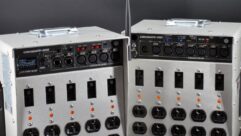The Make or Break Deal
Jan 1, 2002 12:00 PM,
By Peter Mapp
Boardrooms are prestigious, often high-profile venues where important decisions are made and corporate battles fought. So, it’s surprising how many of them suffer from poor acoustics. One might even speculate on how many decisions or takeovers were made not by sheer dint of argument or mutual benefit but simply because the board did not correctly hear what was being said.
Whereas the visual appearance of almost all boardrooms is painstakingly designed to make a statement about the company or authority it serves, the same cannot always be said about the acoustics. Often, it’s the strikingly elegant, hand-crafted materials — polished metals, glass, stone or wood — that have the most unintended and detrimental acoustic impact. These sound-reflective materials can give rise to noticeable imbalances in perceived frequency response and level of natural and reinforced speech. They can also cause undesirable flutter echoes, sound focussing, and spots of poor intelligibility. The architect’s or interior designer’s delight can become the board of directors’ acoustic nightmare.
Curved surfaces, in particular, rank high on the list of culprits. (See Figure 1.) Be they on reflective wall panels or special Italian plaster ceilings with domes or barrel vaults, curves can cause frequency-dependent focussed reflections that make even the most benign board members sound like a cross between Dracula and a Teletubby stuck in a drain pipe.
Even acoustically designed rooms with optimal theoretical reverberation times can suffer from a visual designer’s uneven distribution of sound-absorbing surfaces. When aesthetics dictate placing all the absorption on the ceiling and leaving the walls reflective, for example, highly polarized and reflective sound fields, cross-room echoes and flutter echoes can result. The fact that the room will also contain a large and highly reflective surface — the boardroom table — is often forgotten as well.
MAXIMIZING INTELLIGIBILITY
IF WE HAVE met the reverberation time target and managed to control all noise (see “The Basics of Intelligibility”), there is still no guarantee that speech will be clearly perceived. As we know, certain room shapes or local treatments can give rise to undesirable reflections. Reverberation time and noise control are only the starting points. So let’s look at some of the other contributing intelligibility factors.
Presenter Position
A typical boardroom table layout is shown in Figure 2a. A person talking from a seat located about halfway along the table will have a limited field of intelligible speech transmission. Those seated directly opposite and within a coverage angle around 90° to 100° should be able to hear satisfactorily (depending on the talker’s articulation and voice level). Also, the listeners immediately on either side of the talker, although well off axis, are close enough to receive a useful speech signal. However, those further away and off axis not only suffer from reduced high-frequency (consonant range coverage), but also additional losses due to standard inverse square losses. If the talker turns to face one end of the table, the listeners at the other end will only receive speech that has been diffracted around the talker’s head, which may be up to 15 to 20 dB down at high (consonant) frequencies. (Note, however, that the table can help ameliorate such effects by acting as a useful voice-assisting reflector.)
Placing the presenter at the end of the table (Figure 2b) significantly increases the number of listeners able to receive intelligible speech. Now everyone at the table is within the talker’s coverage angle, although inverse square losses will still take their toll. Listeners towards the end of the table may not be able to hear sufficiently, particularly if they are seated near noisy equipment.
A more in-depth intelligibility analysis should be carried out working on octave-band speech and noise levels and either computing the potential articulation index or STI of the system. Aim for an STI of at least 0.6 to 0.65.
In some rooms, it may be possible to reinforce speech acoustically by adding a reflective element to the ceiling over the boardroom table. If the ceiling is too high, a purpose-built local sound reflector can be added; however, these approaches need to be carefully implemented so that strong vertical reflections between the table and the reflector are avoided. Such reflections may limit the performance of a sound reinforcement system by causing reduced gain before feedback or signal coloration.
Microphone Type and Placement
Microphone and loudspeaker placement is critical to the success of boardroom systems. Place the microphone close enough to the talker to enable sufficient gain before feedback and to ensure reverberation-free signals for teleconferencing applications. This can be easier said than done, particularly when room aesthetics and the sanctity of the table surface are issues, but a number of microphone options and locations are possible.
The locations often favored by the architect or room designer is the ceiling or lighting track. Such positions should be avoided. It’s best to locate the microphone within 24 or, preferably, 18 inches of the talker to ensure adequate gain before feedback — and not many boardroom ceilings are that low. Using a directional mic can help, but not much. A good shotgun or mini-shotgun mic can increase the acceptable distance from mic to talker by a factor of 1.3 to 1.5.
Tabletop boundary microphones can work, but listen to them first, as some sound quite colored due to the mic capsule not being close enough to the real acoustic boundary. A potential problem with boundary microphones is that they can get covered with papers and documents. This can result in them being too far away from the talker to provide effective pickup. A solution is to provide a small standup feature to the table and mount them on this. Alternatively, slim gooseneck mics or miniature shotgun capsules can be used without being too obtrusive. These mics can also work well for accommodating personal laptops.
Compare the two setups in Figure 3. As you can see, a personal laptop computer can block the sound path between a talker and a PZM microphone. A gooseneck, however, can be directed over the top of the computer. But beware of comb-filtering coloration and loss of gain before feedback when using goosenecks. Care with placement and directivity can optimize pickup while minimizing off-axis reflections and associated comb filtering.
Laptops can cause two further problems for the unwary: First, some integral fans are quite noisy, and become even noisier when they have a sensitive microphone right next to them. Second, laptops are a potent source of wideband RF, so pay attention to microphone and cable screening. The RF strength of any wireless mic may also need to be checked, but this should not be a problem in most boardroom-sized installations.
Microphone placement is often hindered by the fact that many designers and board members do not wish to see the microphones, and expect speech to be magically picked up from almost anywhere. Unfortunately, the laws of physics still prevail even in the most prestigious of boardrooms. The standard PAG and NAG equations can be used as indicators of likely success, and creative designers might be persuaded to create a feature to conceal and mount the microphones on or in. But be sure to take an active role in any custom solutions, or the sound might end up even worse than before.
Another mic position that has been tried is the corner edge of the conference table, as shown by the discreet button mic in Figure 3. While this might seem to be an elegant solution, it may not work well in practice as board members reach over or sit forward and obscure their microphones. This setup is also prone to excessive vibration and impact noise pickup unless the capsule is mechanically isolated.
Other options for discreetly locating microphones are special lowered ceiling areas, feature reflectors or even lighting tracks. When looking at such options, don’t just focus on distance, but also beware of potential problems with air movement from ceiling-mounted ventilation systems. Ideally, a number of positions can be tested and the client shown the benefits and weaknesses of each.
When more than two microphones are required, an automatic microphone mixer becomes essential so that the number of open microphones can be strictly controlled and the NOM can be compensated for as required. This optimizes gain before feedback and also reduces extraneous noise and room reverberation pickup that can reduce intelligibility and muddy the sound. Such sounds can be particularly disturbing if the meeting is recorded, relayed elsewhere or used as part of a videoconference.
Loudspeaker Location
Once you have successfully placed the microphones, the next step is to set the loudspeakers. Again this is often a matter of compromise between design and acoustics. The ceiling can be a good option, provided that it is not too high (over about 9 feet). The loudspeakers need to be positioned not over the table, but just behind the attendees, so that the over-spill on the microphones is minimized. Wall-mounted loudspeakers can be used but will not be as discreet. They also require good acoustic wall-treatment to avoid undesirable reflections and flutter echoes.
Mounting the loudspeakers under the front edge of the table can be reasonably discreet and effective. But don’t mount the units too far back from the table’s edge, otherwise the shorter-wavelength, high-frequency components will not reach the listener. People sitting at the table will also mask under-table loudspeakers, but if the loudspeakers are slightly offset from the seat positions, they can cover two listeners at a time.
One of the biggest failings with loudspeaker installations occurs when too few are used and the resultant coverage is too sparse. A direct sound field variation of no more than 3 dB should be aimed for in the 2kHz and 4kHz octave bands. A quick check on the potential gain can be made using the usual PAG and NAG equations or along the lines in Example 2.
This calculation is highly simplified (as are the usual NAG and PAG methods) and does not take into account important factors such as the directivity of the microphone, directivity of the loudspeaker and the reverberant sound level produced in the room. It also assumes that the in-room microphone and loudspeaker responses are essentially flat. Appropriate equalization, therefore, becomes paramount in such systems. Apart from general response shaping with either ⅓-octave or adjustable parametric filters, narrow band notch filters are generally needed in order to achieve the appropriate gain and feedback margin and to control sound coloration produced by either room-mode effects or ring-mode resonance.
TELECONFERENCING
These days, many boardroom systems also act as video or teleconferencing systems, as simplistically shown in Figure 4.
In such a configuration, the two standalone boardroom systems are linked via a teleconferencing unit that includes the telephone interface, echo cancellation facilities and probably a codec to convert the analogue signals to digital for improved bandwidth transmission. The acoustic echo canceller not only removes echo from the line but also reduces the effects of sound pickup in one room on the other. Often it may be desirable to use a separate loudspeaker system for the incoming sound signals rather than trying to electronically mix the incoming and outgoing components, which can lead to an instantaneous feedback loop, unless appropriate switching is incorporated. The echo canceller then reduces the effects of the Room A microphones picking up the sound broadcast from Room B into Room A.
With teleconferencing systems, a higher STI is normally required than for normal boardroom applications to help compensate for the loss of binaural information received by the listener. An improvement of at least 3 to 4 dB SNR is required, and the target STI should be at least 0.7. A slightly shorter reverberation time than that ideally required for a boardroom is also desirable for optimal teleconferencing, with a target of around 0.3 to 0.4 seconds probably being more suitable.
Videoconferencing can help restore the potential intelligibility loss by allowing participants to see the face and lips of the person speaking, which can account for improvements in intelligibility of up to 20%. Interestingly, however, recent research has found that poor video quality can also affect the perceived audio quality. So it would seem that to some extent we hear with our eyes as well as our ears. Now if only architects and interior designers could learn to see with their ears, we might be able to make some real progress in systems installation!
Peter Mapp is senior partner of AMS-Peter Mapp Acoustics, an architectural acoustics and sound-system design consultancy based in the United Kingdom. Mapp is S&VC‘s sound reinforcement consultant and can be reached at[email protected].
THE BASICS OF INTELLIGIBILITY
Reverberation Time
Achieving an optimal reverberation time, while far from guaranteeing good acoustics, should at least get the ball rolling in the right direction. Success can include a range of values, depending upon room volume and usage, but a value of around 0.6 seconds would be a reasonable starting point, as this reverberation time provides both natural voice reinforcement and also maintains overall control so as not to compromise intelligibility.
Noise
Noise is the great intelligibility killer, even more effective at degrading clarity than substandard reverberation. There are many sources of noise that must be controlled or eliminated in effective boardroom design. The most obvious noise source is the HVAC system. A target NC (or RC these days) of 25 to 30 would be a good goal (i.e., maximum 35 dBA).
Noise intrusion and break-in, either from adjacent areas or external sources, such as road traffic, also must be controlled. Ensure that walls and partitions are adequate, that doors are fitted with seals, and that glazing is correctly specified. Remember that acoustic double-glazing requires a considerably greater air gap than its thermal counterpart. Also make sure that the panes are of differing thicknesses, so coincident frequency attenuation loss does not occur. (That’s when a frequency or narrow range of frequencies are hardly attenuated at all, causing a characteristic and attention-drawing whooshing sound, e.g., cars passing by.)
Cross-talk silencers or air conditioning duct lining should be used not only to stop potential noise intrusion but also to ensure that confidentiality within the room is maintained by attenuating potential sound leakage back down the ducts to adjacent areas or offices. Noise from equipment located within the room itself also needs to be carefully controlled. Selecting quieter models is usually the most effective and simplest approach, but sometimes special, acoustically treated enclosures may be required. Remember that if the room is designed to be NC 30, then any individual items of auxiliary equipment will need to be at least 5 to 10 dB below this level.
Example 1: Speech Level Calculation
A quick level calculation can be quite informative and will give an on-the-spot indication as to how far natural speech will be intelligible. Let’s assume that we need at least a 10 dBA signal-to-noise ratio and that the room has a background noise level of 40 dBA (equivalent to approximately NC 35). With an articulate and confident presenter, the voice level at 1 meter will typically be around 60 dBA. So at 3 meters (10 feet) according to the inverse square law, the talker’s voice level will have dropped toward 50 dBA, and so we can just make the target SNR of 10 dBA over the background. But if the talker turns away or walks off axis to the listeners, the intelligibility will drop. Raise the desired SNR to 15 dBA — a reasonable target — and it will only be achieved within just under 6 feet of the talker. Lowering the room background noise level to, say, 35 dBA (roughly NC 30) will restore the original coverage to 10 feet.
Example 2: Estimating Mic Levels
Assume talker voice level at 1 meter is 60 dBA, and the level desired for the listeners is at least 55 dBA (though it often needs to be more than this). Now assume that the microphone is 24 inches away from the talker so that it will be receiving around 64 dBA. Providing a level of 55 dBA at each listener should, therefore, not be a problem, as this is 9 dBA lower than the unity gain of the system when feedback will occur. However, at least a 6 to 9dB margin needs to be added in to maintain feedback stability and also to ensure that the sound is not colored due to regenerative pickup within the acoustic system loop. So, in this case, we just meet the desired level and necessary stability and coloration criteria. But what happens if a quieter talker produces only 55 dBA? The level at the microphone will be 59 dBA, and a stability margin of just 4 dB will exist. This means that the system will be operating on the verge of feedback and can be expected to sound slightly colored.










